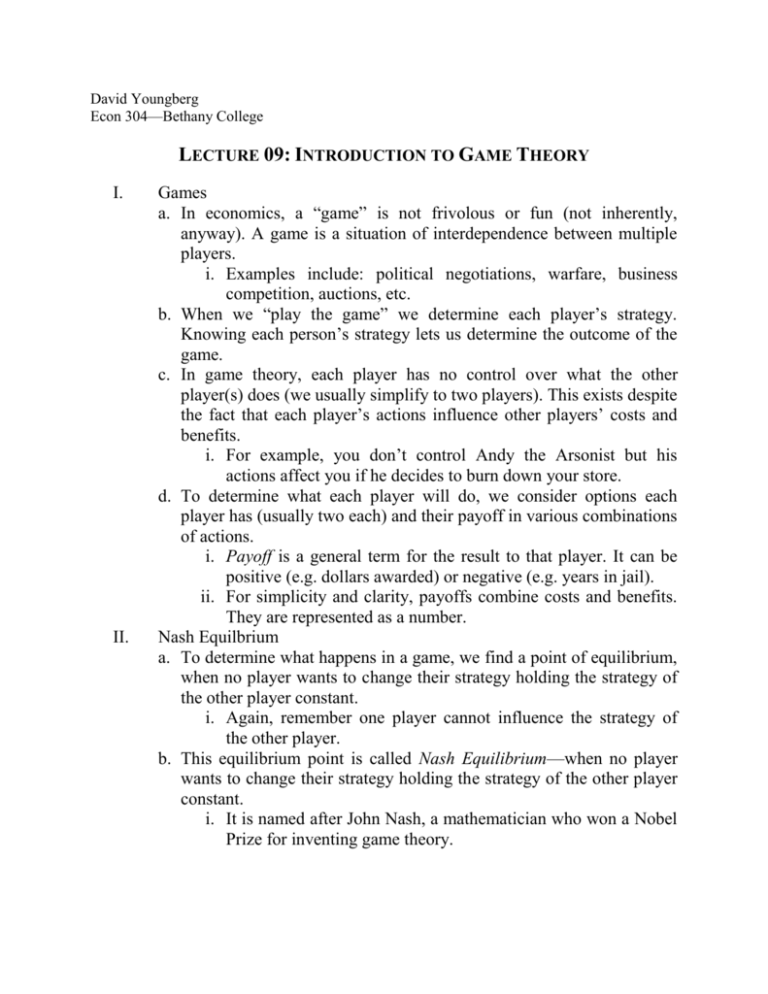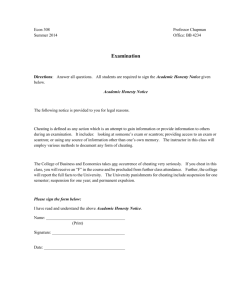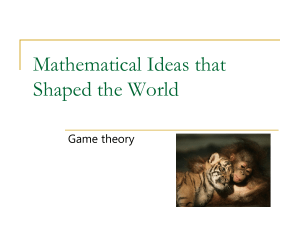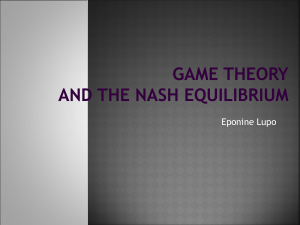02/22 - David Youngberg
advertisement

David Youngberg Econ 304—Bethany College LECTURE 09: INTRODUCTION TO GAME THEORY I. II. Games a. In economics, a “game” is not frivolous or fun (not inherently, anyway). A game is a situation of interdependence between multiple players. i. Examples include: political negotiations, warfare, business competition, auctions, etc. b. When we “play the game” we determine each player’s strategy. Knowing each person’s strategy lets us determine the outcome of the game. c. In game theory, each player has no control over what the other player(s) does (we usually simplify to two players). This exists despite the fact that each player’s actions influence other players’ costs and benefits. i. For example, you don’t control Andy the Arsonist but his actions affect you if he decides to burn down your store. d. To determine what each player will do, we consider options each player has (usually two each) and their payoff in various combinations of actions. i. Payoff is a general term for the result to that player. It can be positive (e.g. dollars awarded) or negative (e.g. years in jail). ii. For simplicity and clarity, payoffs combine costs and benefits. They are represented as a number. Nash Equilbrium a. To determine what happens in a game, we find a point of equilibrium, when no player wants to change their strategy holding the strategy of the other player constant. i. Again, remember one player cannot influence the strategy of the other player. b. This equilibrium point is called Nash Equilibrium—when no player wants to change their strategy holding the strategy of the other player constant. i. It is named after John Nash, a mathematician who won a Nobel Prize for inventing game theory. III. ii. While it was a mathematician who invented game theory, for our purposes all the math game theory involves is of the most basic sort: which of a pair of numbers is biggest? c. An example of Nash Equilibrium sitting in class. Suppose someone is sitting in a seat you’d like to sit in more. Remember, you can’t make them sit elsewhere so you sit where you’re happiest given the choices. Note that people are not constantly changing their seats minute-tominute (or even class to class). We’ve reached Nash Equilbrium. d. If people were to change their seat that indicates that that person could take an independent action and make himself better off. Thus, we are not in Nash Equilibrium. e. We will discuss Nash Equilibrium in more detail when we move onto simultaneous-move games. Sequential-move games a. We begin by abstracting a politics. In this scenario, one player moves and then another moves, etc. Because the players are taking turns, we call this a sequential move game. i. For example, Adriana Alpha and Betty Beta are politicians. Alpha is the incumbent and has announced she will be running for re-election. She is wondering if she should run ads or not. ii. On one hand, ads are expensive and she currently has no challenger. On the other hand, running some ads could deter potential challenger, Betty Beta, from running. iii. Alpha’s choice is if she should run ads or not. Beta’s choice is if she should enter the race or not. iv. The game is described with a series of nodes and decisions: starting from the left and working its way right, ending with different payoffs. The payoffs are listed in order. v. We are curious what the result will be. We usually call this result the rollback equilibrium. Beta Alpha Ads No Ads Run 1,1 Don’t Run 3,3 Run 2,4 Don’t Run 4,2 Beta b. To solve the game, we use a method called backward induction. i. Start at the end of the game: What will Beta do if Alpha plays Ads? What will Beta do if Alpha plays No Ads? “Prune” the strategies Beta will not play. ii. Now you are left with only two outcomes. What will Alpha do? That is the rollback equilibrium. c. Under these circumstances (perfect information and finite trees) rollback equilibrium is a form of Nash Equilibrium called subgameperfect equilibrium—or when a set of strategies such that at each node (subgame) of the game tree, the player would use the same strategy regardless if that node was an independent game or a node in a longer game. i. In other words, each subgame strategy is Nash Equilibrium. ii. Note you will get SPE whenever you use backward induction. By definition, backward induction eliminates all unreasonable strategies, including those involving deception.









